|
|
|
 |
| |
MI6 investigates the literary and cinematic representations of 007's London living quarters...
|
|
At Home With The Bonds
6th March 2011
When it comes to the production design on the James Bond films, we've been truly spoilt. No other film series can truly claim the lavish and inventive sets associated with the Bond films. We've seen hollowed-out volcanoes transformed into rocket bases. We've seen supertankers transform into a submarine pen. We've seen the towers of gold bars in the Fort Knox repository. However, despite these grand creations, throughout the films there has always been one set that never really caught the imagination: James Bond's own apartment.
Throughout the 22 official James Bond films we only get to see the man at home twice; briefly in "Dr. No" as he discovers Sylvia Trench dressed only in one of his shirts and a pair of heels, and then again in "Live and Let Die" when we are introduced to new the 007, in the guise of Roger Moore. However, it has to be said, on both occasions, Bond's flat is something of a let down.
In "Dr. No" we are treated to some of the most beautiful production design from Ken Adam. The lair of Dr. No himself is an incredible group of sets, amongst them a vast control room, a reception area, two adjoining guest rooms and, perhaps most memorable of all, Dr. No's own apartment with a large, plate glass window looking out under the sea, acting as an aquarium.
However, despite creating these incredible sets for "Dr. No", when his attention was turned to Bond's own apartment, he created something rather more traditional and sober. When we consider Bond is associated with the cutting edge of technology, that he is thought of as a man who is of his time, it is surprising that this does not translate to the design of his home.
Right: James Bond (Sean Connery) invites his card-savvy lady-friend back for a nightcap... |
|
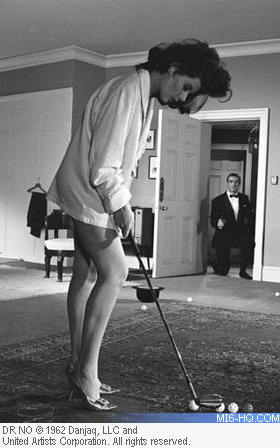
|
This could be due to the fact that "Dr. No" was cinematic Bond's first outing. The image of a cool, contemporary, gadget-laden Bond and the slightly larger-than-life world he inhabits was yet to be defined at this point and so the film-makers stuck more to Fleming's vision of the man. Bearing in mind that the Bond of the books was something of a conservative traditionalist, perhaps it isn't surprising to find that Ken Adam's set reflects this image of Bond, and is ultimately closer to Fleming's description than any of the outlandish creations Adam showcases later in the film.
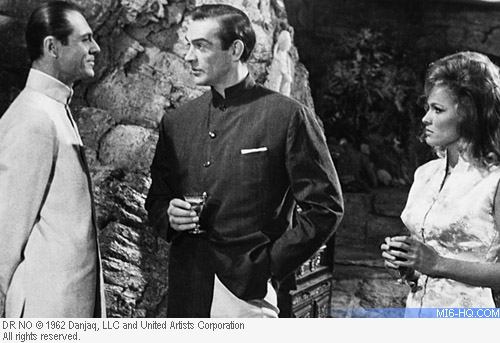 Above: Dinner with Dr. No
Above: Dinner with Dr. No
|
In the novels, Bond's two-bedroom London flat was frequently described by Fleming as small but comfortable and, in "On Her Majesty's Secret Service", Bond wonders if there will be space for Tracy in the flat once they are married. Located in a tree-lined square, just off the King's Road in Chelsea, Bond's flat is on the first floor of a converted Regency house. The living room is book-lined and there is an ornate Empire desk by the broad window. Bond does not own a television, preferring to find his entertainment elsewhere. After all, boredom is the only vice Bond utterly condemns.
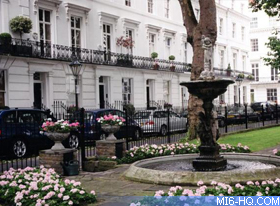
Above: Wellington Square in London, possibly the location of literary Bond's apartment
|
|
In the smallish bedroom, the wallpaper is white and gold striped by Cole & Sons, the curtains are a deep red, contrasting with the dark blue bedspread. The white-tiled bathroom is described as being large, containing a simple, glass shower cabinet and a bath. We know very little about the kitchen other than that it is the domain of May, Bond's Scottish housekeeper, and Bond himself rarely ventures in there. The actual square in question is never specified, however, many have pointed to Wellington Square as a possible location. Interestingly, at one time Fleming himself lived a short distance from here, at 24 Carlyle Mansions on Cheyne Walk. |
However, as more films were produced and the decade moved on, cinematic Bond became increasingly associated with gadgetry and girls, and the character moved further away from Fleming's creation. In the public's imagination, Bond was associated more with Connery's cinematic version, with his blend of charm, danger and sex appeal, than Fleming's literary character.
It was clear that the public appetite for Bond was still as strong as ever, however, with the departure of George Lazenby after "On Her Majesty's Secret Service" and Connery's final turn in "Diamonds Are Forever" it fell to producers to introduce Bond once again. Roger Moore's Bond in "Live and Let Die" would be the third Bond in as many films, and the producers wanted to re-establish all the familiar aspects of the character they could.
So, it is in the eighth 007 adventure, "Live and Let Die", we get to see Bond's home once again, this time the creation of production designer Syd Cain, and perhaps the reason we get this detailed insight into Bond's world is that we are being re-introduced to the character.
Indeed, in "Live and Let Die", Bond's flat reflects the character traits previously established in the film series, and this helps to introduce Moore's Bond to the audience.
The set achieves this in a number of ways: For example, Bond's bedroom is the heart of his flat, almost throne-like, set up high on a split level, taking up most of the frame at the back of the set. |
|
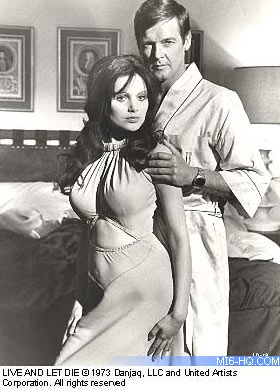
Above: Roger Moore and Madeline Smith pose on the set of Bond's bedroom in "Live And Let Die"
|
This confirms what we already know about Bond, that he is a quite the lover. The small kitchen, set off from the reception, is compact but cutting edge. It is very modern, decorated in stark contrast to the still rather traditional furnishings of the rest of the flat. Within the kitchen Bond uses an espresso machine, something that would have been relatively uncommon in most kitchens in 1973.
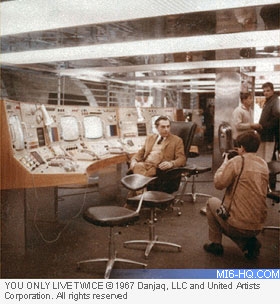
Above: Ken Adam in Blofeld's volcano lair...
|
|
Despite this, the flat in "Live and Let Die" is still something of a disappointment. It does little to capture the imagination and, when compared to some of the other apartments in the series, looks to be rather dull. By comparison, look at Dr. No's apartment in "Dr. No", or, for that matter, Blofeld's apartment in "You Only Live Twice". They are both an incredible mixture of extremely modern and traditional elements, a blend not only of furnishings and fixtures, but also of textures. Rough-hewn rock merges with polished metal surfaces and smooth concrete. Split-levels and asymmetric angles sit next to circular doors and curved fireplaces. It is a triumph of disparate styles - extreme modernism fused with the traditional. Even the guest rooms, the "mink-lined prisons", in Dr. No's facility are beautifully realised. Why could Bond's own apartment not look like this? |
However, there is one apartment from the world of cinema does make me think of what might have been: Catcher Block's apartment in the romantic comedy "Down With Love". This apartment has clearly been inspired by some of Adam's creations (there is something of Osato's office from "You Only Live Twice" and the opium factory from "Goldfinger" about it.) I'd like to think that if Connery's James Bond were to have an apartment, it might look a little like this one.
With all of that said, why should we care what Bond's apartment looks like? Well, one of the reasons is because where you live can tell so much about that person's character. We know really only Bond's preferences when it comes to women, cars and clothes. We know about his culinary tastes, too. But what furniture would Bond have? What art would he like? What would be on his bookshelves? Would there be a television, a music collection? Would there be some mementos from his world travels? All these could tell us so much about the man and add further dimension to his character. We might like to imagine that the modern Bond would have something of a clean, minimal home, but with some of these idiosyncratic elements within them. Perhaps something not unlike the character Craig Mitchell from "Quantum of Solace" whose Barbican apartment was Spartan, yet full of mid-century furnishings and objet.
However, in truth, if there was a cinematic apartment that Bond would own, it would probably be that of George Clooney's character Ryan Bingham from "Up in the Air". Bingham is always traveling and never home and hence his apartment looks like any one of the many hotels he spends most of his life in. Perhaps this is why we never glimpse Bond's home; his life is out there, in the grandiose world of the Bond universe. Can we really blame him? After all, if life really were like a James Bond film, we'd never sit around at home either.
Article By Ben Williams.
|
|
|